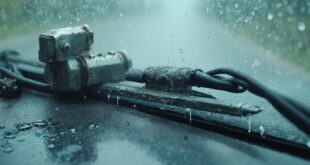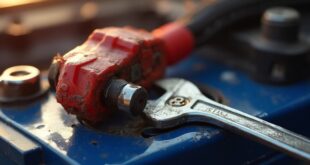To choose the right jumper cables, focus on gauge, length, insulation, and clip material. For most vehicles, 4-gauge or 6-gauge cables work best. Opt for longer cables, around 20 feet, for flexibility in tight spaces. Guarantee cables are well-insulated to avoid damage and increase durability. Solid copper clips provide reliable connections. Understanding these factors will help you make a smart choice for your vehicle needs, and there's more to explore on this topic!
Understanding Jumper Cable Specifications
When it comes to jumper cables, understanding the specifications is essential for guaranteeing a successful jump start. Focus on gauge, length, insulation, clip material, and amperage.
For most vehicles, 4-gauge or 6-gauge cables work best. Consider longer cables, like 20 feet, for flexibility in tight spaces.
Look for well-insulated cables to withstand wear, especially in colder climates. Confirm the clamps are made of solid copper for reliable connections.
Finally, check the amperage requirements; smaller cars may need around 200 amps, while larger vehicles often require 400 amps or more. Knowing these specs helps you choose the right cables for your needs.
Choosing the Right Gauge for Your Vehicle
Choosing the right gauge for your vehicle is essential to guarantee effective jump starts. Thicker cables carry more electricity, making them suitable for larger engines. Here's a quick reference guide to help you select the appropriate gauge:
| Vehicle Type | Recommended Gauge |
|---|---|
| Compact Cars | 6-gauge |
| Sports Cars | 4-gauge |
| Intermediate Vehicles | 6-gauge |
| Full-size Vehicles | 6-gauge |
| SUVs and Minivans | 4-gauge |
For ideal performance, aim for 4-gauge or 6-gauge cables, depending on your vehicle size and requirements.
Importance of Cable Length in Emergency Situations
Cable length plays an essential role in emergency situations, as it directly impacts your ability to connect vehicles safely and effectively.
If your car's battery dies in a cramped parking lot, having longer cables—like 20 feet—gives you the flexibility to reach another vehicle without hassle.
Shorter cables, say 10 feet, might limit your options, forcing you to reposition cars, wasting valuable time.
Plus, longer cables often come with lower gauge ratings, ensuring they can handle the necessary current.
Ultimately, investing in the right cable length can make a critical difference when you need a jump start in a pinch.
The Role of Insulation in Durability and Performance
Having the right length of cables can greatly affect your ability to respond in a tight spot, but insulation also plays an essential role in ensuring your jumper cables last and perform effectively.
High-quality insulation protects against wear, especially in harsh conditions. Here are three key benefits of good insulation:
- Durability: Thick insulation helps prevent fraying and damage over time.
- Safety: Quality insulation minimizes the risk of arcing and short circuits.
- Performance: Well-insulated cables maintain peak conductivity, ensuring reliable jump starts.
Investing in properly insulated cables can save you headaches down the road.
Evaluating Clip Materials for Effective Connections
When it comes to jumper cables, the material of the clips can considerably impact your ability to make effective connections. Copper clips offer the best conductivity, ensuring reliable power transfer. On the other hand, plated clips may corrode over time, compromising performance.
| Clip Material | Advantages |
|---|---|
| Copper | Excellent conductivity |
| Copper Plated | More affordable, decent use |
| Aluminum | Lightweight, but less effective |
| Steel | Often too weak, unreliable |
Investing in high-quality copper clips will enhance your jump-starting experience, helping you avoid frustration when you need it most.
Determining Amperage Needs Based on Vehicle Type
Understanding the amperage needs of your vehicle is essential for effective jump-starting.
Different vehicles require varying levels of amperage for peak performance. Here's a quick guide to help you determine what you need:
- Compact Cars: Usually need around 200-400 amps.
- SUVs and Minivans: Aim for 400-800 amps for reliable starts.
- Full-Size Vehicles: Typically require 600 amps or more for best results.
Jumper Cables for Different Vehicle Categories
Choosing the right jumper cables for your vehicle category can make all the difference in a successful jump start.
For compact cars, 6-gauge, 10-foot cables with 400 amps work well. Sports cars need at least 4-gauge cables, preferably 2-gauge for added performance.
Intermediate vehicles benefit from 6-gauge, 10-foot cables, while full-size vehicles should opt for 4-gauge, 20-foot cables for reliability.
SUVs and minivans require 4-gauge, 10-foot cables, with 2-gauge, 20-foot cables recommended for maximum power.
Always match your jumper cables to your vehicle's requirements to guarantee effective and efficient jump starts every time.
Safety Precautions When Using Jumper Cables
Jump starting your vehicle is only part of the process; guaranteeing your safety while doing so is just as important. Follow these precautions to minimize risks:
- Wear Safety Gear: Always wear safety goggles and gloves to protect yourself from battery acid and sparks.
- Check Connections: Guarantee both vehicles are off before connecting cables, and avoid letting clamps touch each other.
- Inspect Batteries: Look for corrosion or swelling on battery terminals. If you notice leaks, get professional help immediately.
Frequently Asked Questions
Can I Use Jumper Cables on Hybrid or Electric Vehicles?
Yes, you can use jumper cables on hybrid or electric vehicles, but you should follow specific guidelines. Always consult your vehicle's manual for proper jump-starting procedures to guarantee safety and avoid damaging the system.
How Often Should I Check My Jumper Cables for Wear?
You should check your jumper cables for wear every few months or after each use. Look for fraying, cracked insulation, or rusted clamps. Regular inspections guarantee they're ready when you need them most.
What Should I Do if My Jumper Cables Get Wet?
If your jumper cables get wet, dry them thoroughly before use. Inspect for any damage, as moisture can cause corrosion. Store them in a dry place to prevent future issues and guarantee safety during jump-starts.
Can I Use Any Car Battery for Jump-Starting?
You can't use just any car battery for jump-starting. Confirm the donor battery matches your vehicle's voltage and amperage needs. It's vital to avoid damage and guarantee a successful jump-start for your battery.
Is It Safe to Jump-Start a Car With a Swollen Battery?
It isn't safe to jump-start a car with a swollen battery. A swollen battery indicates potential leaks or internal damage, which could cause explosions or further harm. Always seek professional assistance in such situations.
 Car Service Land Coupons for Oil change, Tires, Wheel alignment, Brakes, Maintenance
Car Service Land Coupons for Oil change, Tires, Wheel alignment, Brakes, Maintenance




